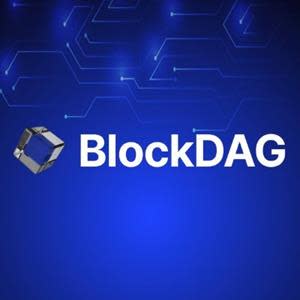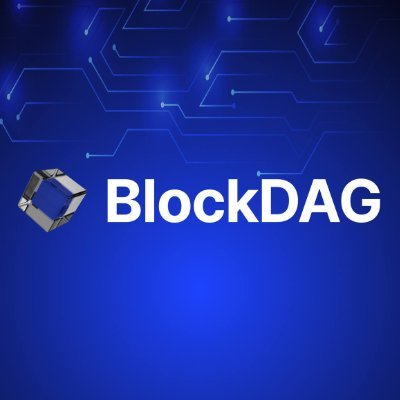
LONDON, UK, March 28, 2024 (Globe Newswire) — Cryptocurrency mining has long come under scrutiny for its excessive energy consumption and associated environmental impact. In 2022, the White House found that crypto assets will account for 0.4% to 0.9% of the world's total annual electricity consumption, exceeding the energy use of some individual countries.
However, a recent study published in the journal PNAS proposes a partnership between crypto mining and green hydrogen production as a potential means of accelerating the transition to clean energy while promoting broader adoption. We offer In this article, we will delve into the dynamics of Bitcoin and Ethereum mining and present: BlockDAG Network Explore how these project approaches can contribute to democratizing the industry while supporting renewable energy initiatives.


The study presented in PNAS highlights the potential for synergies between crypto mining and green hydrogen production, and envisions a scenario where profits from mining activities can be reinvested into clean hydrogen production and renewable energy projects. ing. This innovative solution involves using crypto profits to indirectly drive the expansion of solar and wind energy through the production of green hydrogen.
Bitcoin:
Bitcoin operates on a proof-of-work (PoW) consensus mechanism and has traditionally relied on energy-intensive mining operations, primarily powered by fossil fuels. However, the PNAS study offers an optimistic outlook on Bitcoin's potential role in expanding renewable energy. This signals a shift for Bitcoin mining to clean energy sources, with mining operations carried out by energy companies or climate change-focused groups rather than traditional individual miners. This transition aims to democratize space, ensuring that revenues from mining are channeled into sustainable energy projects.


BlockDAG network:
BlockDAG Network offers a new approach to transaction processing that is distinctly different from traditional blockchain consensus methods. Unlike linear blockchains like Bitcoin, which place transactions in consecutive blocks, BlockDAG employs a graph-like structure facilitated by directed acyclic graphs (DAGs) to increase parallelism and scalability. make it possible. With the introduction of mining solutions, BlockDAG Network aims to usher in a new era of accessibility and democratization in the passive income generation industry.
By leveraging the unique properties of DAGs, BlockDAG Network has pioneered a system that allows users to seamlessly integrate machines into everyday homes, rather than restricting mining to energy-inefficient large-scale operations. . Unlike traditional blockchain networks that rely on Proof of Work (PoW) mechanisms and centralized computing power; Block DAG Eliminates the need for expensive specialized mining hardware. Instead, it takes a more holistic approach and allows individuals to participate in the mining process using affordable mining rigs that cost less than $1,500 and can be purchased on the website. This accessibility allows anyone with an internet-connected computer or smartphone to immediately start mining activities and generate passive income.
Through innovative home mining solutions, BlockDAG Network democratizes access to the cryptocurrency ecosystem, empowering individuals around the world to actively participate in block creation and validation while creating economic benefits for everyone. Reshaping the digital currency landscape for


Ethereum:
Ethereum previously operated on the same unsustainable proof-of-work (PoW) mechanism as Bitcoin. However, on September 15, 2022, Ethereum made a transition and replaced the PoW mechanism with an alternative mechanism known as Proof of Stake (PoS). Ethereum’s transition from proof-of-work to proof-of-stake is known as the “merge” and promises to significantly reduce power consumption. Ethereum co-founder Vitalik Buterin predicted that the move to PoS would reduce global electricity usage by 0.2% and crypto carbon emissions by 99.992%. The Crypto Carbon Rating Institution reported that immediately after the merger, Ethereum's energy consumption and carbon footprint achieved an astounding 99.99% reduction.
This change eliminated the network of energy-intensive mining devices that previously competed to create the next block on the underlying blockchain. Instead, wealth became a crucial factor in the block creation process under PoS. Coins are staked as collateral and the software randomly selects the stakeholder to create the next block. Unlike PoW, where the possibility of earning rewards depended on the use of more energy-intensive devices, PoS incentivizes earning higher stakes to increase the probability of creating new blocks.
Currently, Ethereum PoS shows significant improvement over PoW in terms of power consumption.


Decentralization is essential for blockchains to function effectively, but it often comes with an environmental cost. This situation appears to be about to change, as Bitcoin and Ethereum mining and BlockDAG network mining have the potential to drive a more sustainable and democratic future within the crypto industry. By embracing innovation, inclusion and sustainability, these projects can pave the way to a greener, more resilient digital future.
Read the summary BlockDAG presale:
Website: https://blockdag.network
Advance sale: https://purchase.blockdag.network
telegram:https://t.me/blockDAGnetworkOfficial
discord: https://discord.gg/Q7BxghMVyu
Disclaimer: The information provided in this press release is not intended as a solicitation to invest, nor is it intended as investment advice, financial advice or trading advice. Before investing in or trading in virtual currencies or securities, we strongly recommend that you exercise due diligence, including consulting with a professional financial advisor.
CONTACT: Brown Williams support at blockdag.network



